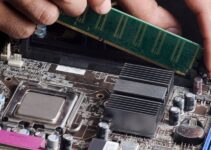Does DDR4 RAM Speed Matter? DDR4’s maximum official clock speed is 3200MHz, while DDR5’s minimum clock speed is 4800MHz, representing a 50% increase.
Despite a significant increase in latency, from CL14 in most 3200MHz DDR4 kits to CL40 in the majority of 4800MHz DDR5 kits, DDR5 is expected to be faster. So, does RAM speed matter? The short answer is that it depends.
What is DDR4?
If you don’t have time to read the complete article you may listen the audio
The most recent RAM design, known as DDR4 RAM, is extensively employed in the next generation of computers.
DDR4 can provide maximum efficiency and faster speed due to its lower voltage and greater transfer rates.
Double Data Rate Fourth Generation Synchronous Dynamic Random-Access Memory is the official name of DDR4 SDRAM
Features of of DDR4
Following are some key characteristics of the DDR4 SDRAM type:
- Lower signaling threshold.
- 8 times less power.
- Improved write signaling with prefetch.
- Dynamic ODT.
- Fly-by structures.
- Write/Read Leveling.
- Driver appointing.
- Mirroring DIMM address after device reset.
- A better device pinout.
Advantages of DDR4
Here are some pros/benefits of DDR4:
- Higher module densities and very low power consumption are both features of DDR4.
- High-speed gaming is best suited for DDR4.
- More DIMM capacities are provided by DDR4.
- When compared to older versions, the data rate transfer is quicker.
- Without the need for cooling, DDR4 can transport data at greater rates while operating at very low voltage.
- DDR4 has the lowest latency of all the DDR variants.
- DDR4 uses less power because it only performs self-refreshes to update its material.
Factors Affecting RAM Performance

RAM Overclocking Basics: The clock frequency or speed is a crucial factor in determining the output performance of RAM.
Higher frequency leads to improved data transfer rates and memory bandwidth. Similar to overclocking CPUs or GPUs, Memory can also be overclocked to achieve better performance.
Reducing CPU-RAM Latency:Lower latency results in reduced CPU-RAM connection time, although the data transmission per second remains unchanged.
It is more challenging to manually decrease latency than to increase it, and most people avoid doing so. XMP can be used to automatically set the Memory to the highest frequency and shortest latency.
Trade-offs in Frequency and Latency: Usually, frequency and latency are trade-offs, and changing both can be difficult.
Hence, it is generally recommended to increase the frequency alone during overclocking instead of increasing both frequency and latency.
Memory Channel Configurations: The memory channels are determined by the CPU and RAM, not the settings.
Most motherboards and processors have two memory channels, and dual-channel mode uses two or four Memory sticks. Using single-channel RAM can result in high memory bandwidth costs.
Improving Processor Performance with RAM: Processors require a vast amount of quickly transferable data, and even though some processors like the Ryzen 7 5800X3D have 96 MB of shared cache, Memory becomes the bottleneck as soon as the CPU requests data.
Therefore, faster Memory is expected to improve performance. However, not all software utilizes RAM in the same way, and some programs or games may require faster RAM depending on how you use your computer.
Read Also: Is 128GB Enough for Gaming on a Laptop
Examining RAM Performance in Applications and Games

Performance with RAM upgrades: What performance benefits can you expect from switching to dual-channel RAM, increasing frequency, or reducing latency? It’s difficult to provide a straightforward answer, so we’ll limit ourselves to well-known applications and games.
Single vs. Dual-Channel Memory Comparison: Few people or publications compare single-channel versus dual-channel memory because most people use two RAM sticks without hesitation. This is particularly important for laptops since many of them have only single-channel memory or only have half of their memory installed in RAM slots and the other half soldered to the board. Ultrabook Review tested the Asus Zephyrus G14 to see how terrible single-channel Memory was.
Impact of Single-Channel RAM: Switching from dual- to single-channel RAM had an impact on most applications, from synthetic benchmarks to gaming. The G14’s 2060 Max-Q should be the limiting factor, so the gaming benchmarks are notable. In Shadow of the Tomb Raider, performance declined by about 20%. If this were a faster laptop or desktop that could play games at a higher frame rate, the differences between the single- and dual-channel RAM benchmarks would be even greater.
Memory Frequency and Latency: Techspot tested the frequency and latency of DDR4 and DDR5 memory using various applications and video games on Intel’s 12th-generation Alder Lake Processors. In most cases, latency and frequency are not critical. Adobe Photoshop 2022 exhibited almost no performance differences between slower and faster Memory. In most games, the fastest 6200MHz DDR5 memory was only marginally faster than the slowest 2400MHz DDR4. Cyberpunk 2077 and Hitman 3 showed 29% and 15% higher frame rates, respectively, when using 6200MHz RAM.
The value of fast RAM: While a fast RAM kit doesn’t always boost performance, it’s still a wise choice. A 16GB package of DDR4 2400MHz RAM currently costs about the same as a 16GB bundle of 3600MHz Memory. Therefore, it is worth spending a few extra dollars for the 3600MHz.
DDR5 for Ryzen/Raptor Lake :DDR5 memory is not worthwhile for Alder Lake users since it costs nearly twice as much as DDR4 memory. DDR4 should work fine, although Ryzen 7000 and Raptor Lake users may prefer DDR5.
Dual-channel mode is crucial: The main factor determining memory performance is dual-channel mode, which is easy to enable and improves the performance of applications and games (with two or four RAM sticks). Timing occasionally matters but infrequently.
Read Also: Is 128gb RAM Enough for Business Student Laptops
Where The RAM Speed Comes into Play
| Friendly Name | Industry Name | Peak Transfer Rate | Date Transfer/Second (in Millions) |
| DDR4-2400 | PC4-21300 | 21300-MB/s | 2666 |
| DDR4-2933 | PC4-23400 | 23400-MB/s | 2933 |
| DDR4-3000 | PC4-24000 | 24000-MB/s | 3000 |
| DDR4-3200 | PC4-25600 | 25600-MB/s | 3200 |
| DDR4-3600 | PC4-28800 | 28800-MB/s | 3600 |
| DDR4-4000 | PC4-32000 | 32000-MB/s | 4000 |
| DDR4-4400 | PC4-35200 | 35200-MB/s | 4400 |
What situations don’t prioritize Memory capacity over speed? RAM speed is more important than motherboard compatibility.
The generation of a motherboard affects RAM speed, so with motherboards that only support 3000 MHz, 3200 MHz RAM would be wasted. The Memory will still function, but only at the motherboard’s limit rather than the RAM’s.
RAM compatibility with the ASUS ROG Strix Z490-E Gaming motherboard:

Any DDR5 memory operating at those frequencies is supported by the motherboard. The maximum speed possible without overclocking is 2666 MHz.
Before purchasing memory and deciding on the speed, it’s important to consider the motherboard specifications. Buying 4000 MHz RAM for that board would be excessive if you don’t plan to overclock or push it beyond its limits.
Matched Pairs
Make sure your motherboard can use them before mixing RAM sticks, and keep an eye on the speed. While some memory modules can be mixed, most don’t. If so, buy RAM with the same speed. RAM will slow down in this case.
Read Also: Is 8GB RAM Enough for Next 5 Years?
FAQs: Does DDR4 RAM Speed Matter
What If I Get DDR5?
DDR4 to DDR5 migration is near. RAM speed increases will continue. Games won’t be greatly impacted by RAM speed. You’ll typically get a few more frames per second, but gaming demands more processing and graphics power. Also, make sure your motherboard is DDR5 compatible.
It will be a great upgrade to your system when DDR5 is affordable and will help to future-proof it for a few years, but the focus will still be on the gigabytes of RAM, not the speed.
What DDR4 Memory speed is recommended?
The best DDR4 memory speeds are 3,200MHz for Intel processors and 3,600MHz for the most recent AMD processors. For work and gaming, your processor should have enough bandwidth.
Does the speed of the memory matter?
Does the performance gap between RAM speeds really matter? It does indeed. Yet not every user experiences the same level of performance improvement.
For gaming, do memory speeds matter?
Having memory that can run at high speeds offers many benefits when it comes to gaming. The performance and frame rate of the game can be improved by raising the RAM speed, albeit it won’t have as much of an effect as changing the processor or graphics card.
DDR4 3200MHz: Is it quick?
In 2023, will 3200MHz RAM be seen as being fairly quick? Yes, it is still a relatively quick RAM speed.
Can I use 3200MHz RAM in a motherboard that runs at 2666MHz?
Yes, RAM running at 3200MHz will work well on motherboards that only support 2666MHz.
What occurs when memory is used too quickly?
Let’s say you try to install and utilize a RAM module that has a quicker speed than the CPU and motherboard can handle. In that situation, the system’s performance can become unstable, and there might be issues with the computer starting up.
Is it preferable to get quicker RAM or more RAM?
Performance usually becomes better with faster memory. The right kind of RAM can make all the difference; more memory doesn’t always equate to quicker performance. Faster memory might reduce latency or increase bandwidth.
Is DDR4 4000 expensive?
According to our testing, high-end systems like a Ryzen 9 3950X or Core i9 10900K with an RTX 2080 Ti, where consumer PC gaming is at its peak, are the only ones that make sense for RAM speeds of 4000MHz or above. However, such RAM can be quite expensive. Set your RAM’s XMP speeds in the BIOS.
Can I swap out DDR4 3200 for DDR4 2666?
Yes, you can swap out DDR4 3200 for DDR4 2666. In terms of normal use and gaming, the performance of 2666MHz and 3200MHz RAM is similar. Programs and tasks that require a lot of RAM may benefit from 3200 RAM’s faster memory.
Is DDR4 superior to DDR5?
DDR5 is the newer generation of memory and offers increased speed and capacity over DDR4. Modern software and games will benefit from the increased speed and capacity of DDR5 memory. However, DDR4 is still more affordable and effective in most cases.
Conclusion
In concluding remarks I would say that DDR4 RAM always matters but depends various factors. High frequency improves the speed of data transfer.
Memory is essential to improve data transferring speed. often people use dual to single channel RAM to create impact on applications but the difference between single and dual channel RAM does not have greater difference. we would say that dual channel mode will determine the performance.
Read More:



